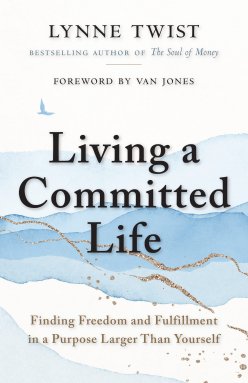
Lynne Twist. Living a Committed Life. Berrett-Kohler, 2023.
The title of Living a Committed Life tells it all. This written in the tradition of other motivational books. Dale Carnegie may be the best known example. This may be a bit different in that the author spends a lot of time sharing her own experiences. Whatever else one can say, the author thinks big.
She had a kind of epiphany as a young mother around thirty when she met the famous architect Buckminster Fuller. He made her think big. He also was the first of many of her advisors who said to see possibilities rather than problems. Yes, that sounds like a cliché, and there are other similar pieces of advice—except that her own experiences show that they can work.
This is very much an elitist book in the sense that the author is extremely well connected. “Bucky” Fuller is just one of many names that she drops. To be honest, she is not dropping them to impress us, but illustrating how these people learned to navigate the upper atmosphere of the socioeconomic and political worlds. At one point she said that she worried because she was traveling the world rather than staying at home with her kids. (They could afford help.) Her children told her it was fine because they got to meet so many interesting and famous people from all around the world.
Probably the most significant example of commitment for this reviewer was her short tale of how when she was a young mother she was insecure in her relationship with her husband. At some point she realized that they truly were committed. She could be secure in that relationship. A lot of those connections she made were through her husband.
A few years ago everyone was asking, “What is your passion?” Now college applicants are told not to use the word passion on their applications because it has become a cliché. I suspect that will not happen with the word commitment.
Other proverbs she shares that sound wise: Worry is a form of negative prayer. It is not happiness that makes us grateful; it is gratitude that makes us happy.
The author’s main commitment, if you will, has been to end hunger. Fuller convinced her that the resources to feed everyone exist, it is just a matter of making use of them. In her work in this area, she has traveled all over the world and met many different people. She also got involved in restorative justice, and her stories about this are the most moving. The ability to forgive and restore people after brutal civil wars in African countries is in some ways miraculous—but the author shows that it is necessary.
Some aspects of this book are typical of the elites: worries about global overheating, blaming the patriarchy, questioning Western culture, a vague spirituality, even skepticism about democracy. This is an excellent book to see how the one percent thinks and behaves. It can be exhilarating to think that many of the people with wealth and/or power are trying help others. But it can be scary to think that many of the same people believe that government regulation will force people to behave in a way that the elites want them to.
The author gives a key to getting along with others: not you versus me, but you and me. She illustrates this with a legislative compromise in which Trump Republicans and at least some Progressives could agree on. (Van Jones, the author of the book’s introduction, was instrumental in this.) Ironically, she has little good to say about Trump, even though Richard Kiyosaki, one of Trump’s co-authors, also attributes his vision and success to motivation that came from Buckminster Fuller.
At its root this is a motivational book. Of all the various motivational speakers and writers I have come across, the author is most like Ralph Waldo Emerson. Emerson abandoned Christianity and then Unitarianism for pantheism. Living a Committed Life takes a pantheistic approach as well. The word Emerson liked was enthusiasm. Commitment is probably more effective and enduring, as long as the commitment is to something worthwhile.
The author talks of “spirituality.” She speaks of religious people of all kinds: Christian monks and nuns, Buddhist priests, Muslim poets, and Amazonian shamans. It requires a certain amount of discernment to read Living a Committed Life. See I John 4:1ff. However, if the reader can get past the “Mush God” aspect of this book, it has some very moving examples and may get some people to see things from a new frame of reference.